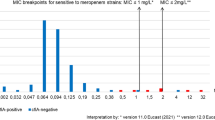Summary
In infections of polymicrobial etiology, it seems mandatory to combine an antibiotic with marginal activity against anaerobes with an anti-anaerobic drug, e. g. metronidazole or clindamycin. We investigated the effect of associations of anaerobic and facultatively anaerobic pathogens on MBCs of enoxacin, clindamycin, metronidazole, and combinations of enoxacin plus clindamycin or metronidazole. Single testing, and associations ofBacteroides fragilis withEscherichia coli orEnterococcus faecalis revealed MBCs of 64 mg/l for enoxacin. However, investigating metronidazole, MBCs forB. fragilis increased from 0.5–1 mg/l to 2–4 mg/l in association withE. coli. The combination of enoxacin with metronidazole restored MBCs of 0.5 and 1 mg/l for theB. fragilis strains.B. fragilis associated withE. faecalis showed MBCs of 2 to 64 mg/l for metronidazole, an increase of up to 64-fold. The enoxacin MBCs forE. coli in association withB. fragilis were up to eight-fold higher than forE. coli alone (2 mg/l compared to 0.25 mg/l). Association ofE. coli withE. faecalis andB. fragilis showed a low to moderate increase for MBCs ofE. coli when enoxacin was tested alone or in combination with metronidazole or clindamycin. In contrast, MBCs forE. faecalis did not change significantly with any of the associations or combinations tested. It is evident thatin vitro antimicrobial susceptibility of associations of pathogens can be modified by interactions between strains, and/or antimicrobials.
Zusammenfassung
Bei polymikrobiellen Infektionen ist es wesentlich, Chemotherapeutika ohne oder mit nur schwacher Wirksamkeit gegen Anaerobier mit Metronidazol oder Clindamycin zu kombinieren. Die Auswirkungen der Assoziationen von anaeroben und fakultativ anaeroben Erregern auf die MBK von Enoxacin, Clindamycin, Metronidazol und den Kombinationen Enoxacin plus Clindamycin oder Metronidazol wurde untersucht. Die MBK vonBacteroides fragilis sowohl in Einzel- als auch in Assoziationstestung mitEscherichia coli oderEnterococcus faecalis betrug für Enoxacin 64 mg/l. Bei der Testung von Metronidazol stiegen die MBKs vonB. fragilis in Assoziation mitE. coli von 0.5–1 mg/l auf 2–4 mg/l, während sich in der Kombination Enoxacin plus Metronidazol wieder MBKs von 1 mg/l ergaben. In den AssoziationenB. fragilis mitE. faecalis zeigteB. fragilis bei der Untersuchung von Metronidazol MBKs von 2 bis 64 mg/l, ein bis zu 64facher Anstieg gegenüber der Einzeltestung. Die Enoxacin-MBKs fürE. coli in Assoziation mitB. fragilis waren bis zu achtfach höher als in Einzeltestung (z. B. Anstieg von 0.25 auf 2 mg/l). Assoziationen vonE. coli mitE. faecalis undB. fragilis ergaben fürE. coli einen geringeren Anstieg der MBKs für Enoxacin, Enoxacin plus Metronidazol oder Clindamycin. BeiE. faecalis konnten keine wesentlichen Veränderungen der MBKs in den verschiedenen Assoziationen beobachtet werden. Aus den Versuchen kann geschlossen werden, daß dieIn-vitro-Empfindlichkeit gegen antimikrobielle Substanzen bei Erregerassoziationen durch Interaktionen zwischen den Stämmen und/oder den antimikrobiellen Substanzen beeinflußt werden kann.
Similar content being viewed by others
References
Siporin, C., Towse, G. Enoxacin: Worldwidein-vitro activity against 22451 clinical isolates. J. Antimicrob. Chemother. 14 (1984) 47–55.
Phillips, I., King, A. Comparative activity of the 4-quinolones. Rev. Infect. Dis. 10 suppl. 1 (1988) S70-S76.
Malmborg, A. S., Rannikko, S. Enoxacin distribution in human tissues after multiple oral administration. J. Antimicrob. Chemother. 21 suppl. B (1988) 57–60.
Sapico, F. L., Canawati, H. N., Witte, J. L., Montgomerie, J. Z., Wagner, Jr., F. W., Bessman, A. N. Quantitative aerobic and anaerobic bacteriology of infected diabetic feet. J. Clin. Microbiol. 12 (1980) 413–420.
Wilkins, T. D., Chalgren, S. Medium for use in antibiotic susceptibility testing of anaerobic bacteria. Antimicrob. Agents Chemother. 10 (1976) 495–502.
NCCLS. National Committee for Clinical Laboratory Standards: Tentative standard M7-7T. Standard method for dilution antimicrobial susceptibility tests for bacteria which grow aerobically. National Committee for Clinical Laboratory Standards, Villanova, PA (1983).
DIN. Deutsche Industrienorm: Methoden zur Empfindlichkeitsprüfung von bakteriellen Krankheitserregern (außer Mykobakterien) gegen Chemotherapeutika. Bestimmung der minimalen Hemmkonzentration nach der Agar-Verdünnungsmethode. DIN 58940, Teil 6 (1979).
Ingham, H. R., Hall, C. J., Sisson, P. R., Tharagonnet, D., Selkon, J. B. The activity of metronidazole against facultatively anaerobic bacteria. J. Antimicrob. Chemother. 6 (1980) 343–347.
Moran, F. J., Perez, C., Hurtado, C., Blanco, M. T., Prieto, J. Thein vitro activity of metronidazole against Enterobacteriaceae alone and in mixed cultures withBacteroides fragilis. J. Antimicrob. Chemother. 20 (1987) 657–661.
Dubreuil, L., Devos, J., Beerens, H., Romond, C.: Activitéin vitro de l'association ofloxacine-métronidazole sur les anaérobies stricts. Cinétique d'action du métronidazole surBacteroides fragilis. Path. Biol. (1988) 488–492.
Brook, I. The role of β-lactamase-producing bacteria in the persistence of streptococcal tonsillar infection. Rev. Infect. Dis. 6 (1984) 601–607.
Brook, I. Effect ofStreptococcus faecalis on the growth ofBacteroides species and anaerobic cocci in mixed infection. Surgery 103 (1988) 107–110.
Sheagren, J. N. Treatment of skin and skin structure infections in the patient at risk. Am. J. Med. 76 Suppl. (1984) 180–186.
Author information
Authors and Affiliations
Rights and permissions
About this article
Cite this article
Heizmann, W.R., Schmid, R., Heilmann, F. et al. Association experiments with aerobic and anaerobic pathogens: a model of in-vitro susceptibility testing in mixed infections. Activity of enoxacin, clindamycin, and metronidazole. Infection 17, 160–164 (1989). https://doi.org/10.1007/BF01644018
Received:
Accepted:
Issue Date:
DOI: https://doi.org/10.1007/BF01644018




